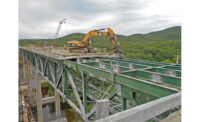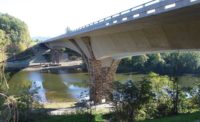In the bucolic town of Brookfield, Vt., crews are finishing work on the world's first composite floating bridge. It is the eighth iteration of the original log bridge built in 1820, after a town resident fell through ice and drowned in what is now called Sunset Lake.
The 318-ft x 20-ft, single-lane Brookfield Bridge, which carries Vermont Route 65 across the lake, employs a fiber-reinforced polymer (FRP) flotation system with a 100-year design life. Construction of the $2.4-million bridge began in April 2014 and is scheduled for completion by Memorial Day weekend.
After removing the old structure, crews installed cofferdams and are now constructing new concrete abutments. "Putting a cofferdam on a ledge [at one end] was challenging, but we overcame it," says Paul Holloway, project manager with Miller Construction, Windsor, Vt. "Two pontoons bonded together equal a raft, and five rafts spliced together equal the bridge," he says.
Beginning in August, "we launched the pontoons one at a time on five different days, since the manufacturing process is long," Holloway says. "We made a fabrication table out of steel girders. When the pontoons showed up on the flatbed truck, we unloaded them with a crane and put them on the fabrication table, where they were bonded together with resin." Crews installed the last pontoon in late December, just before the lake froze.
The new structure replaces a 37-year-old crossing comprising 380 barrels, 50 gallons each, that began to leak. The timber structure supporting the deck became submerged, according to the Vermont Agency of Transportation (VTrans).
The thin plastic, styrofoam-filled barrels on the bridge "were becoming saturated and deteriorating," says Jennifer Fitch, VTrans project manager. The bridge was closed in 2008.
In 2012, VTrans asked T.Y. Lin International for a solution. "The past two bridges were built as cribwork, with flotation between them," says Josh Olund, T.Y. Lin bridge engineer. "The new system allows for portions to be removed, if necessary, without pulling the bridge out of the water. The biggest challenge was figuring out the different loading conditions on the bridge and defining its [buoyant] service capacity," Olund says.
The team also accommodated 5.5-ft natural lake-depth fluctuations by using rotating ramps with specially designed bearings and joints, Olund adds.
Since design codes for FRP bridges do not exist, the team worked with the VTrans and the University of Maine to develop a set of criteria. "We initially considered hinged connections [for the pontoons] but opted for monolithic rigid connections, due to driver-comfort considerations," Olund says.
T.Y. Lin approached Augusta-based Kenway Corp. to help with the conceptual design. Kenway applied techniques used for "marine camels"—giant floating fenders that protect piers from a submarine, says Jake Marquis, Kenway senior project engineer. "The same fiberglass, vinyl ester resin and flotation foam were used," he says. Kenway employed a T.Y. Lin splice-plate design that uses a steel plate to bolt one pontoon raft to the next.
"We built molds, fabricated the pontoons and staged them in the yard, matching up the plates and drilling over 1,000 bolt holes at our facility before delivering them to the site," he says. "We built all of the pontoons out of one mold."
Marquis says the design could work for other marine structures, including floating docks, wharfs, barges, floating pedestrian bridges and temporary military bridges. Adds Fitch, "We're using FRP floats to deliver a long-lasting and low-maintenance historic resource."








Post a comment to this article
Report Abusive Comment